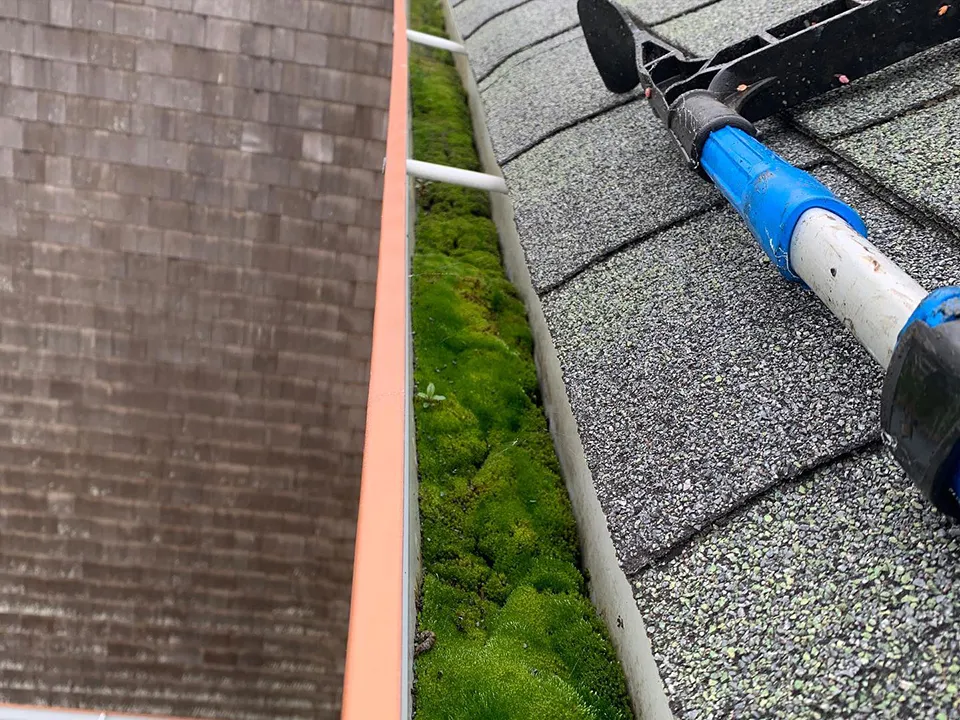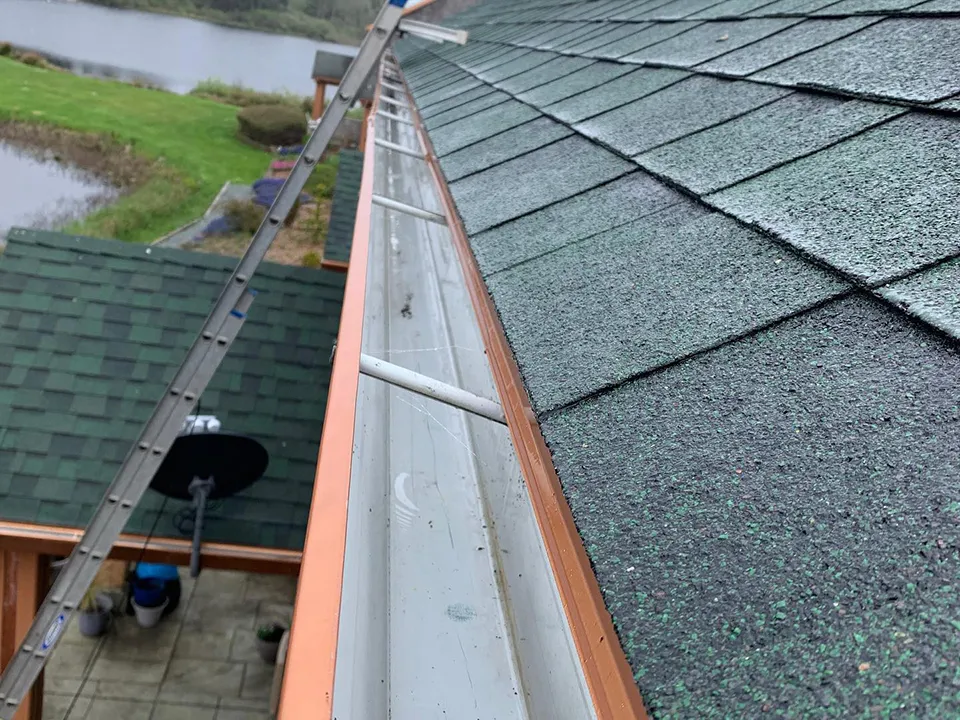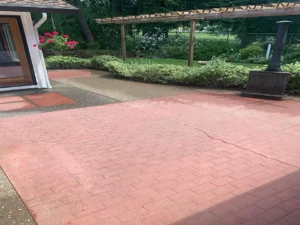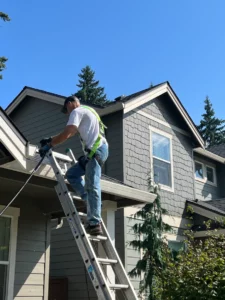The Role of Gutter Cleaning in Preventing Basement Flooding
Your basement stays dry for months, maybe even years. Then one heavy rainstorm hits, and you discover water seeping through the foundation walls or pooling on the floor. While many homeowners immediately suspect plumbing issues or foundation problems, the real culprit often lurks overhead—clogged, damaged, or poorly maintained gutters.
Basement flooding causes thousands of dollars in damage annually for American homeowners. According to the Insurance Information Institute, water damage and freezing account for nearly 29% of all homeowners insurance claims. Yet many of these incidents could be prevented with proper gutter cleaning.
Your home’s gutter system serves as the first line of defense against water damage. When functioning correctly, gutters channel rainwater away from your foundation, preventing the conditions that lead to basement flooding. When they fail, the consequences can be devastating and expensive.
Understanding Gutters: Anatomy and Function
Your home’s modern gutter system is a network of interconnected components designed to protect its foundation. Horizontal gutters collect rainwater, vertical downspouts guide it down, and extensions direct it safely away. Gutter guards, end caps, and hangers complete the system. For optimal performance, gutters need proper slope and capacity to handle rainfall, with durable materials that withstand weather changes. A functional system is crucial: even a single inch of rain on a 1,000-square-foot roof can yield 623 gallons of water, which, if not diverted, would lead directly to foundation issues and basement flooding.

The Connection: Gutters and Basement Flooding
The relationship between gutter health and basement dryness centers on water management around your foundation. When gutters overflow or fail to direct water away from your home, that water seeks the path of least resistance—often directly into your basement.
Soil Saturation and Hydrostatic Pressure
Overflowing gutters can lead to excess moisture around your foundation, increasing hydrostatic pressure on basement walls and potentially causing leaks. Clay-heavy soils worsen the issue by retaining water, expanding when saturated, and exerting extra pressure. Over time, this expansion-contraction cycle can create small cracks that grow into significant leak points. Proper drainage and maintenance are key to preventing these issues.
Foundation Settlement and Erosion
Clogged gutters lead to soil erosion around your foundation, causing uneven settling, cracks, and gaps that allow water to enter during storms. Poor drainage can also weaken your home’s footing, leading to structural shifts and new leak points. Proper gutter maintenance is essential to prevent these issues.
Window Wells and Basement Windows
Basement window wells act as collection points for overflow from damaged gutters. When gutters dump water directly next to your home instead of directing it away, window wells can fill like bathtubs during heavy rains. The pressure from standing water often overcomes window seals, flooding your basement through these below-grade openings.
Warning Signs: Recognizing Potential Issues
Early identification of gutter problems can prevent basement flooding before it occurs. Regular inspection reveals developing issues while they’re still manageable and affordable to address.
Visual Indicators
Look for these visual signs of gutter problems:
- Overflowing water: During rain, water spilling over the sides suggests clogs, improper slope, or undersized gutters.
- Water stains: Marks on your home’s exterior walls below the gutters point to chronic overflow.
- Sagging gutters: This indicates structural issues, often from the weight of debris and water.
- Gaps: Openings between gutter sections let water escape before it reaches the downspout.
- Plant growth: Plants or weeds in your gutters are a clear sign of accumulated debris and poor drainage.
Foundation and Basement Clues
Inspect your basement for signs of moisture. Key indicators include:
- Efflorescence: White, chalky deposits on foundation walls, which signify water has moved through the concrete.
- Musty odors: These often point to moisture issues before visible water damage occurs.
- High humidity: Basement humidity consistently above 60% suggests a drainage problem.
- Foundation cracks: Look for new or expanding cracks in foundation walls, especially after heavy rain, as they can indicate water pressure issues.
Landscape and Drainage Indicators
Watch how water flows during rain. It should move away from your foundation, not pool. Persistent wet spots or erosion around downspouts indicate poor drainage. Dying plants near the foundation can also signal water management issues.

DIY Gutter Cleaning: A Step-by-Step Guide
Regular gutter cleaning prevents most drainage-related basement flooding issues. With proper tools and safety precautions, many homeowners can maintain their gutters effectively.
Safety First
Ladder safety is crucial for DIY gutter maintenance. Always use a sturdy extension ladder placed on solid, level ground. Follow the 4-to-1 rule: for every four feet of height, the base of the ladder should be one foot away from the wall. Never lean the ladder directly against the gutter, as this can cause damage and instability. For added safety, have someone spot you and avoid working in windy or wet conditions.
Essential Tools and Materials
Before you begin, gather your tools. You’ll need heavy-duty work gloves to protect your hands, a small garden trowel or gutter scoop for efficient debris removal, and a bucket or tarp to collect the mess. A garden hose with a spray nozzle is essential for flushing the system. For a thorough job, consider a small mirror for tricky spots and basic tools for any minor repairs you might find.
The Cleaning Process
Start at a downspout and methodically clear debris along each gutter section. Remove large pieces by hand, then use a trowel or scoop for stubborn, packed material, taking care not to damage the gutter. Once visible debris is gone, flush the gutters with a garden hose, starting from the opposite end. This flushes out remaining blockages and verifies proper water flow, ensuring water drains freely without pooling. Pay close attention to downspout connections, as these are common clog points. If water backs up, flush downward through the opening. For persistent clogs, a plumber’s snake or professional assistance may be necessary.
Post-Cleaning Inspection
Use the cleaning opportunity to inspect your gutter system thoroughly. Check for loose hangers, gaps between sections, or signs of rust and corrosion. Test the stability of the entire system by gently shaking sections to identify loose connections.
Examine downspout extensions to ensure they direct water at least six feet from your foundation. Shorter extensions may not provide adequate protection during heavy rainfall events.
Professional Help: When to Call A+ Exterior Cleaning
While DIY maintenance handles routine cleaning, certain situations require professional expertise. A+ Exterior Cleaning specializes in comprehensive gutter services that go beyond basic cleaning to address underlying problems that threaten your basement’s safety.
Comprehensive System Evaluation
Professional gutter services include thorough system evaluation that considers your home’s specific drainage needs. A+ Exterior Cleaning assesses factors like roof size, regional rainfall patterns, and landscape grading to ensure your gutter system provides adequate protection.
This evaluation often reveals issues beyond simple cleaning needs. Professionals can identify foundation grading problems, recommend landscape modifications, or suggest gutter guard installations that reduce future maintenance requirements.
Preventive Maintenance Programs
Regular professional maintenance prevents small problems from becoming major issues. A+ Exterior Cleaning offers scheduled maintenance programs that keep your gutters functioning optimally year-round, reducing the risk of basement flooding from neglected systems.

Long-Term Prevention: Maintenance Tips
Preventing basement flooding through gutter maintenance requires ongoing attention beyond periodic cleaning. Implementing a comprehensive maintenance strategy protects your investment while minimizing emergency situations.
Seasonal Maintenance Schedule
Different seasons present unique challenges for gutter systems. Spring cleaning removes winter debris and identifies damage from ice and snow. Summer maintenance focuses on managing organic growth and preparing for storm season. Fall represents the most critical cleaning period, as leaf accumulation can quickly overwhelm gutter capacity.
Winter preparations include ensuring proper drainage before freezing temperatures create ice dams. Even in moderate climates, freezing and thawing cycles can damage gutters filled with debris and standing water.
Gutter Guards and Protection Systems
Installing quality gutter guards significantly reduces maintenance requirements while improving system reliability. Modern gutter protection systems filter out leaves and large debris while allowing water to flow freely.
However, gutter guards aren’t maintenance-free solutions. They still require periodic cleaning and inspection to function effectively. Choose guards appropriate for your local tree types and debris patterns for optimal performance.
Landscape Integration
Coordinate your gutter system with overall landscape drainage for maximum effectiveness. Ensure downspout extensions direct water to areas where it can safely infiltrate or flow away from your home. Consider installing french drains or dry wells in areas with poor natural drainage.
Maintain proper grading around your foundation to complement your gutter system’s water management. The ground should slope away from your house at least six inches over the first ten feet to encourage surface water runoff.
Protecting Your Basement Through Proactive Gutter Care
Your gutters are more than just roof accessories; they’re a key part of your home’s water management system and your best defense against a flooded basement. The link between clean gutters and a dry basement is direct and undeniable.
Regular gutter maintenance, whether DIY or professional, is far cheaper than the cost of basement flood cleanup, mold removal, and foundation repairs, which can run into thousands of dollars.
Don’t wait for a storm to discover a problem. Schedule a gutter inspection and cleaning today. For expert service that addresses your home’s unique drainage needs, contact A+ Exterior Cleaning. Their knowledge in water management will give you peace of mind, knowing your basement is secure. Protecting your basement starts with proactive gutter care.
https://www.google.com/maps?cid=9581861370272832557




